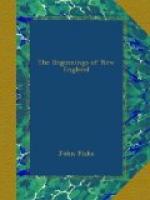shows the importance which was attached to the case.
After seven days of discussion, the vote was taken.
Seven assistants and eight deputies approved the former
decisions, two assistants and fifteen deputies condemned
them, while seven deputies refrained from voting.
In other words, Captain Keayne has a decided majority
among the more aristocratic assistants, while Mrs.
Sherman seemed to prevail with the more democratic
deputies. Regarding the result as the vote of
a single body, the woman had a plurality of two; regarding
it as the vote of a double body, her cause had prevailed
in the lower house, but was lost by the veto of the
upper. No decision was reached at the time, but
after a year of discussion the legislature was permanently
separated into two houses, each with a veto power upon
the other; and this was felt to be a victory for the
assistants. As for the ecclesiastical polity
of the new colony, it had begun to take shape immediately
upon the arrival of Endicott’s party at Salem.
The clergymen, Samuel Skelton and Francis Higginson,
consecrated each other, and a church covenant and
confession of faith were drawn up by Higginson.
Thirty persons joining in this covenant constituted
the first church in the colony; and several brethren
appointed by this church proceeded formally to ordain
the two ministers by the laying on of hands.
In such simple wise was the first Congregational church
in Massachusetts founded. The simple fact of
removal from England converted all the Puritan emigrants
into Separatists, as Robinson had already predicted.
Some, however, were not yet quite prepared for so radical
a measure. These proceedings gave umbrage to
two of the Salem party, who attempted forthwith to
set up a separate church in conformity with episcopal
models. A very important question was thus raised
at once, but it was not allowed to disturb the peace
of the colony. Endicott was a man of summary
methods. He immediately sent the two malcontents
back to England; and thus the colonial church not
only seceded from the national establishment, but
the principle was virtually laid down that the Episcopal
form of worship would not be tolerated in the colony.
For the present such a step was to be regarded as
a measure of self-defence on the part of the colonists.
Episcopacy to them meant actual and practical tyranny—the
very thing they had crossed the ocean expressly to
get away from—and it was hardly to be supposed
that they would encourage the growth of it in their
new home. One or two surpliced priests, conducting
worship in accordance with the Book of Common Prayer,
might in themselves be excellent members of society;
but behind the surpliced priest the colonist saw the
intolerance of Laud and the despotism of the Court
of High Commission. In 1631 a still more searching
measure of self-protection was adopted. It was
decided that “no man shall be admitted to the
freedom of this body politic, but such as are members
of some of the churches within the limits of the same.”
Into the merits of this measure as illustrating the
theocratic ideal of society which the Puritans sought
to realize in New England, we shall inquire hereafter.
At present we must note that, as a measure of self-protection,
this decree was intended to keep out of the new community
all emissaries of Strafford and Laud, as well as such
persons as Morton and Gardiner and other agents of
Sir Ferdinando Gorges.




